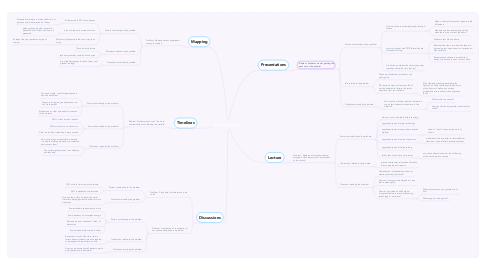
1. Mapping
1.1. Problem: Students cannot understand concepts covered
1.1.1. Factors contributing to the problem
1.1.1.1. Bullet points in PPT not adequate
1.1.1.1.1. Presents information in a linear fashion, but perhaps some information isn't linear
1.1.1.2. a lot of material is covered in class
1.1.1.2.1. perhaps changing what material is presented out of class and how it is presented
1.1.1.3. Material is presented in the same way, (one way!)
1.1.1.3.1. Perhaps this only reaches one type of learner
1.1.2. Information related to the problem
1.1.2.1. Class is mostly lecture
1.1.2.2. tech savvy teacher, could be drawn upon
1.1.3. Questions raised by the problem
1.1.3.1. Are there better ways to teach, learn, and present biology?
2. Timelines
2.1. Problem: Students cannot see "the story" and therefore aren't learning the material
2.1.1. Factors contributing to the problem
2.1.1.1. Too much media, can't distinguish events from the eachother
2.1.1.2. Cannot see long range either, events do not "tie together"
2.1.1.3. Students do not feel a personal connection to the material
2.1.2. Information related to the problem
2.1.2.1. 50% of class time on lectures
2.1.2.2. 50% of class time on discussion
2.1.2.3. Class meets 40 minutes/day, 5 days a week
2.1.3. Questions raised by the problem
2.1.3.1. How can we lay out events and moments in a way that allows students to understand and connect them?
2.1.3.2. Can social media be used in an effective and safe way?
3. Discussions
3.1. Problem: Class time for discussions is too small
3.1.1. Factors contributing to the problem
3.1.1.1. 75% of class time is spent on lecture
3.1.1.2. 25% is dedicated to discussion
3.1.2. Questions raised by the problem
3.1.2.1. How can the in-class time and the out of class time be reorganized to allow for more discussion
3.2. Problem: Distribution of conversation is not even and etiquette is a problem
3.2.1. Factors contributing to the problem
3.2.1.1. Some students speak way too much
3.2.1.2. Some students do not speak enough
3.2.1.3. Students do not understand "rules" of discussion
3.2.1.4. Some students talk over each other
3.2.2. Information related to the problem
3.2.2.1. Because so much of the class time is lecture based, students are not prepared to participate during discussion time
3.2.3. Questions raised by the problem
3.2.3.1. How can we ensure that all students get to participate more in class time?
4. Presentations
4.1. Problem: Students are not getting the most out of the material
4.1.1. Factors contributing to the problem
4.1.1.1. Course is almost exclusively taught through lecture
4.1.1.1.1. Need a variety of instruction types to reach all learners
4.1.1.1.2. Students can lose interest very quickly when there's too much of the same
4.1.1.2. Lecture is taught with PPT Slides which are dense and boring
4.1.1.2.1. Slides are text rich and dense
4.1.1.2.2. Students don't learn as well when they are just seeing text, need visuals to correspond with such text
4.1.1.2.3. Because these slides are emailed, low student motivation to even come to class.
4.1.1.3. No hands on exploration time during class (perhaps during lab time though)
4.1.2. Info related to the problem
4.1.2.1. Slides are distributed to students as a study guide
4.1.2.2. 80 minutes a week of class time, 40 of which dedicated to lecture, the rest to questions from the students
4.1.2.2.1. If the students aren't understanding the material, it's likely that the question portion of the class isn't well spent, as they probably don't even know which questions to ask.
4.1.3. Questions raised by the problem
4.1.3.1. How can this professor alter her instruction to give the students more access to the material?
4.1.3.1.1. What media can she use?
4.1.3.1.2. How should she incorporate media into her slides?
5. Lecture
5.1. Problem: Students only receive material through in class lecture, but one class has to be missed.
5.1.1. Factors contributing to the problem
5.1.1.1. older, not as comfortable with technology
5.1.1.2. apprehensive about using technology
5.1.1.3. apprehensive about using other people's material
5.1.1.3.1. need to "ease" into using the work of others
5.1.1.4. apprehensive about online discussions
5.1.1.4.1. make them look as similar to the traditional classroom as possible to ease nervousness
5.1.1.5. apprehensive about online testing
5.1.1.6. talker, likes face to face discussions
5.1.1.6.1. use online discussion forum, then follow up at the next in person session
5.1.2. Information related to the problem
5.1.2.1. previous assignments/activities limited to lecture, papers, and reports
5.1.3. Question raised by the problem
5.1.3.1. How effective is blended instruction at meeting learning objectives?
5.1.3.2. How can a classroom be flipped in a way that is meaningful?
5.1.3.3. How can you make an adult digital immigrant feel more comfortable using technology in instruction?
5.1.3.3.1. What resources can you provide him or her?
5.1.3.3.2. What support can be given?

